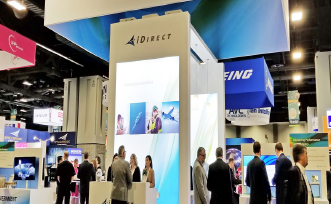Satellite 2019
by Elisabeth Tweedie
Washington, D.C., May 15, 2019--It’s hardly surprising that two topics dominated Satellite 2019 in Washington this year, were: the low earth orbit (LEO) constellations, and 5G. Topics that are constantly in the news, and are in fact related. Although many of the applications do not require it, low latency is one of the specifications of the 5G standard; therefore many operators feel that the LEO constellations are necessary for the satellite industry to be fully integrated into 5G.
 As we all know there are a myriad of potential LEO systems. However only a few of these are attracting media attention: OneWeb, Telesat, LeoSat, and SpaceX. In the last week these have been joined by another big name: Amazon. In fact, there has been no announcement from Amazon itself, but its filings with the ITU have been noticed. The system, known as Project Kuiper, is described as a network of 3,236 satellites, operating in three orbital levels: 367 miles, 379 miles and 391 miles. These would provide coverage of the globe from 56 degrees north to 56 degrees south, effectively covering everywhere south of Moscow and North of Cape Horn, in other words most of the populated world.
As we all know there are a myriad of potential LEO systems. However only a few of these are attracting media attention: OneWeb, Telesat, LeoSat, and SpaceX. In the last week these have been joined by another big name: Amazon. In fact, there has been no announcement from Amazon itself, but its filings with the ITU have been noticed. The system, known as Project Kuiper, is described as a network of 3,236 satellites, operating in three orbital levels: 367 miles, 379 miles and 391 miles. These would provide coverage of the globe from 56 degrees north to 56 degrees south, effectively covering everywhere south of Moscow and North of Cape Horn, in other words most of the populated world.
In a session entitled “Constellations: Do the business models close?” Tom Wayne, CFO OneWeb, made light of the Amazon announcement, and of the other potential operators. “Of course, there will be competition, but we will be there first.” He also stated that OneWeb would be profitable after a couple of years in operation. This confidence in first mover advantage was also reiterated by Alex Streckel, the new CEO of OneWeb: “We will have first mover advantage……our second generation of satellites will start to go up, when others will be at the first generation.”
Interestingly, OneWeb, which like O3b, started with a primary target market of the unserved, in this case schools in developing nations; recently announced a change of focus; maritime is now its primary target market. Given that there are no inter-satellite links in the constellation, this may prove challenging. Alex Clavel, Managing Director of SoftBank, OneWeb’s major investor, pointed out that “ROI is first and foremost, and then you will have the bandwidth for Schools.” He emphasized the importance of doing good, “the human value of what we are doing is very important to us as an investor.”
Both OneWEb and Telesat emphasized the need for a diversified approach to to user terminals. OneWeb stating that it had a range of terminals now in place, both flat panel and dual parabolic.
Amazon, of course is no stranger to space, it has an agreement with Lockheed Martin to Integrate its ground network and with Verge, Lockheed Martin’s ground network for LEO systems. These of course include not only the “big” names that we’re all familiar with, but also the numerous cubesats already operational. According to Joseph Portale, Senior Program Manager, Lockheed Martin Space Systems, Verge will be operational over the contiguous United States by 2020, with further expansion around the globe planned.
The initial network will deploy traditional parabolic antennas, but the possibility of moving to electronically steered antennas in the future is being considered. Lockheed Martin is developing its own electronically steered antenna, but according to Portale: “We haven’t yet got the cost metrics right.” Verge will be available to users of the LEO systems on a “pay per minute” basis. Companies using Verge, can have their satellite data directly downloaded to Verge and pushed to the AWS cloud, with the intention of providing faster access to the data, regardless of where the user is located.
In addition AWS are building their own ground stations which will be integrated into the Verge Network. The current target is to build 12 by the end of the year. These will be located in the different amazon regions of which there are 16. By integrating the two networks, users will be able to request data from the satellites through their AWS account and have it downloaded to the nearest Verge ground station.
In the opening session “What’s the next big idea?” Shayn Hawthorne, Senior Manager and AWS Ground Station Program Lead, Amazon Web Services, security is a big issue. He emphasized the need for the same level of security for the whole value chain, that exists for a computer network. Given the number of data breaches that we continue to hear about on an almost daily basis, one has to question whether this is adequate security for a satellite network. Lisa Callahan, VP & GM Commercial and Civil Space, Lockheed Martin, echoed the need for security, looking to a future where it satellites would be so flexible that it would be possible to upload an app to change the mission after the satellite is in orbit.
5G Over Satellite
As already mentioned, many in the industry are counting on 5G to bring new business to the satellite industry – and the LEOs in particular; and an equal number are skeptical as to whether 5G over satellite is even feasible.
In as session entitled “Factoring 5G into the Future of Satellite Service Providers”, Thomas Van den Driessche, CEO, Newtec stated that 5G over satellite was definitely possible, explaining that for the last two weeks Newtec had been conducting tests with Vodafone, using Telesat’s demonstration LEO satellite, to trial running a 5G core over satellite. As part of the test, 8K streaming was demonstrated showing only 18-34 millisecond latency. This is better than the existing terrestrial systems and was achieved without optimizing the ground segment.
In the same session Georg Mayer, SA TSG Chairman, 3rd Generation Partnership Project (3GPP), talked about the need to integrate satellite into the 5G ecosystem. Mayer asked the satellite industry to get more involved with the 3GPP and to clearly indicate what was needed to fully integrate satellite into the 5G network. The European Satellite Operators Association (ESOA) joined the 3GPP 18 months ago, but Mayer stated that there was plenty of room for other players in the industry to get involved.
Following on from the recent revelation about Project Kuiper, Jeff Bezos, founder of Amazon and of Blue Origin, called a press conference scheduled to start four hours after Satellite 2019 ended. Speculation was rife that he was going to reveal more about the satellite project and its (presumably) launch company. However, he had something else to announce. Earlier in the conference Mike Pence had stated that the US would send a man to the moon by 2024. Bezos obviously took that as a personal challenge, and chose to use the press conference to announce Blue Moon, a lunar lander. Elon Musk, founder of SpaceX, has made no secret of the fact that he wants to build colonies on Mars. Bezos took a somewhat different approach, talking about trillions living in space in colonies which will be built by future generations.
Women in the Industry
It wasn’t very long ago, that ladies were a relative rarity on the stage at the satellite show. Now, although we remain a minority, seeing a lady on the stage is a common occurrence. This year, in a session entitled “Our Collective Role In Empowering Women and Cultivating Diversity in Aerospace”, there were no less than eight, very successful ladies on the stage. Almost all of them are pioneers, and had to push themselves forward in order to gain a toehold in the industry. Rebecca Cowen-Hirsch, Senior VP of Government and Policy Strategy, Inmarsat Government Services, described how she resorted to leaving her first name off her resume, when she first started looking for engineering jobs. Debra Facktor, VP and General Manager Ball Aerospace said that speaking the common language of maths and science helped breakdown gender barriers. Nevertheless, in spite of the increasing numbers of women in senior management positions, the challenges are not yet over. Charity Weedon, President and Co-founder, Liquinox Consulting, pointed out that women still make 87 cents for every $1 a man male engineering.
But not all the ladies in the industry are engineers, and even if they are, when they are working in a startup, they also need to speak the language of finance. Kay Koplovitz, founder of Madison Garden Sports Network, has started a foundation to help women secure funding and “speak investor speak.” 82% of the startups the foundation has helped are still in business. Depending on which source you use, typical startup success rates in the USA, vary from 25 to 50%, so either way, 82% is a very impressive figure!
Given that only 21% of women, earn engineering degrees, Celeste Ford, Founder and Chair, Stellar Solutions suggested that tackling the issue, of getting more women into aerospace, we should start at the beginning and start encouraging girls in high school. As for getting ahead once someone is in the industry simple solutions were suggested, such as not being afraid to ask for help, something that equally applies to men, although the prospect of that happening was greeted with humor during the session. Probably the most encouraging pointer to the future was the fact that the session was well attended and well over half of the attendees were men.
--------------------------------------------
 Elisabeth Tweedie has over 20 years experience at the cutting edge of new commmunications entertainment technologies. She is the founder and President of Definitive Direction (www.definitivedirection.com), a consultancy that focuses on researching and evaluating the long-term potential for new ventures, initiating their development, and identifying and developing appropriate alliances. During her 10 years at Hughes Electronics, she worked on every acquisition and new business that the company considered during her time there. She can be reached at etweedie@definitivedirection.com.
Elisabeth Tweedie has over 20 years experience at the cutting edge of new commmunications entertainment technologies. She is the founder and President of Definitive Direction (www.definitivedirection.com), a consultancy that focuses on researching and evaluating the long-term potential for new ventures, initiating their development, and identifying and developing appropriate alliances. During her 10 years at Hughes Electronics, she worked on every acquisition and new business that the company considered during her time there. She can be reached at etweedie@definitivedirection.com.





